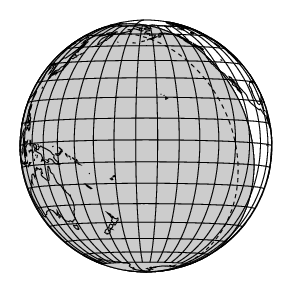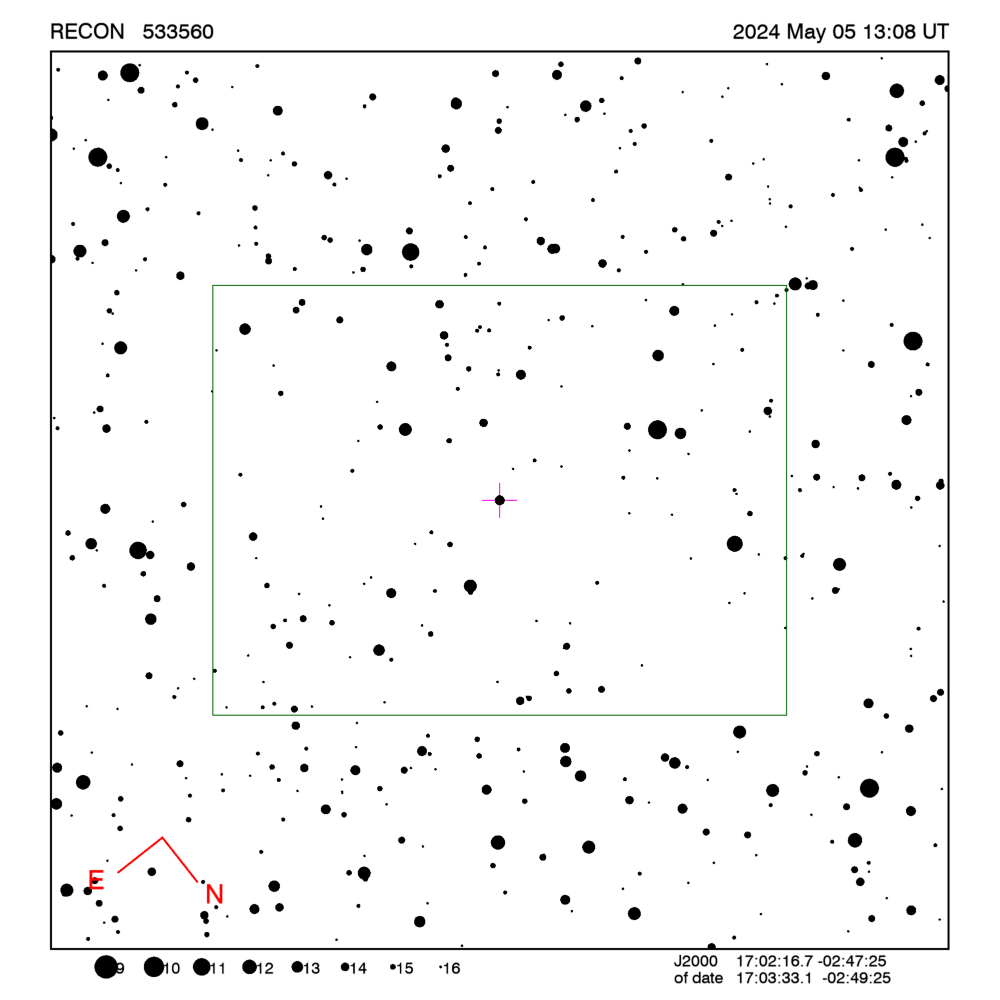RECON: TNO occultation with 533560
Event between (533560) 14JM80 and star GA0860:05241949
with event index number of 2586996
Geocentric closest approach at 2024/05/05 13:07:55 UTC
J2000 position of star is 17:02:16.7 -02:47:25
Equinox of date position of star is 17:03:28.2 -02:49:17
Stellar brightness G=14.1,
use SENSEUP=64 with the MallinCam and and exposure
time of 1 seconds with the QHY174 camera.
Star is 114 degrees from the moon.
Moon is 9% illuminated.
TNO apparent brightness V=22.5
 TNO is 46.8 AU from the Sun
and 46.0 AU from the Earth.
TNO is 46.8 AU from the Sun
and 46.0 AU from the Earth.
The TNO is moving 21.4
km/sec on the sky relative to the star, or,
2.3 arcsec/hr.
The 1-sigma error in the time of the event is 225 seconds.
The 1-sigma cross-track error in the shadow position is
3438 km.
The TNO has an absolute magnitude Hv=5.8
Diameter=436.5 km assuming a 5% albedo -- 19.5 sec chord
Diameter=178.2 km assuming a 30% albedo -- 8.0 sec chord
Dynamical classification is SCATNEAR
Star training set for 533560, (2024/05/05 13:08UT)
Object RA Dec mag sep mel
Antares 16:30:54.2 -26:29:02 0.9 24.92 120
13Zet Oph 16:38:30.1 -10:36:52 2.6 9.97 120
PPM 179990 17:06:47.6 -00:55:25 5.4 2.07 113
PPM 200274 17:02:57.8 -03:48:11 8.3 0.99 114
PPM 200296 17:04:54.4 -03:01:35 9.4 0.39 114
PPM 200297 17:05:01.3 -02:53:38 10.1 0.37 114
533560 17:03:33.1 -02:49:25 14.1 114
Positions are for equinox of date

Azimuth is measured in degrees eastward from north.
North is at an azimuth of 0, due East is at an azimuth
of 90 degrees, due South is 180, and due West is 270.
Do not use the listing below for the RECON CPC 1100 telescopes.
This is provided for other non-team facilities.
Star training set for 533560, (2024/05/05 13:08UT)
Object RA Dec mag sep mel
Antares 16:29:24.4 -26:25:56 0.9 24.92 120
13Zet Oph 16:37:09.6 -10:34:01 2.6 9.97 120
PPM 179990 17:05:32.2 -00:53:32 5.4 2.07 113
PPM 200274 17:01:40.9 -03:46:10 8.3 0.99 114
PPM 200296 17:03:37.9 -02:59:38 9.4 0.39 114
PPM 200297 17:03:44.9 -02:51:41 10.1 0.37 114
533560 17:02:16.7 -02:47:25 14.1 114
Positions are for J2000
Event circumstances last updated at 2022/10/12 04:20:14 UT
Marc W. Buie,
Southwest Research Institute
RECON
 TNO is 46.8 AU from the Sun
and 46.0 AU from the Earth.
TNO is 46.8 AU from the Sun
and 46.0 AU from the Earth.
